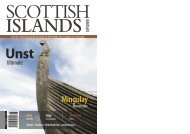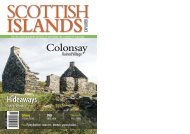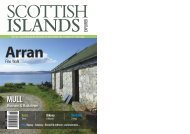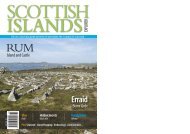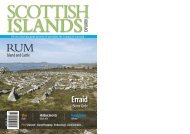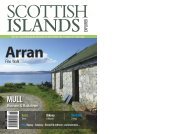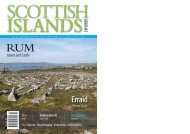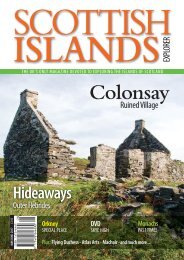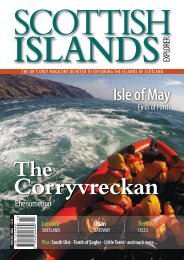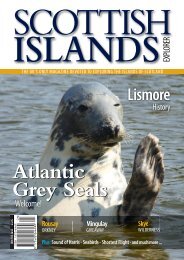Create successful ePaper yourself
Turn your PDF publications into a flip-book with our unique Google optimized e-Paper software.
Colonsay’s Ruined Village<br />
Colonsay’s Ruined Village<br />
declined throughout that century and mirrored the change<br />
in numbers on Colonsay as a whole. In 1841, 68 people<br />
were recorded living in 14 households. The residents even<br />
included incomers from Mull and Jura, but 30 years later<br />
there were only 49 inhabitants in nine houses.<br />
Ten years on, it appears only five houses were still<br />
occupied and numbers had fallen to just 19. They rose in<br />
the next census but, by then, the island population had<br />
dramatically fallen from its peak of 979 in 1841 to less than<br />
400 and only 25 residents remained on the eve of the First<br />
World War.<br />
face peers out from the top of the monument and the two<br />
arms of the cross contain carefully shaped spirals.<br />
The base terminates in the shape of a fish-tail and the age<br />
of the cross implies that the vicinity may have had special<br />
significance before settlement. King Edward VII and<br />
Queen Alexandra visited Colonsay House in 19<strong>02</strong> and<br />
planted commemorative rhododendrons in the subtropical<br />
woodland around St Oran’s Well. The King<br />
apparently caused some amusement by noting that the face<br />
on the cross “Was a very good likeness of the chief engineer<br />
on the royal yacht.”<br />
Page 17 l-r: The ruins of Riasg<br />
Buidhe seen from the hill to the<br />
south of the village. Colonsay’s<br />
new fish farm can be seen offshore,<br />
with Scarba beyond.<br />
This house stood at the western<br />
end of the village row and, in its<br />
later days, was fitted a roof of<br />
tarred felt.<br />
An old rusty bedstead is slowly<br />
engulfed by grass.<br />
This man-made basin, used to<br />
grind barley, can be seen on the<br />
top of a rock in the graveyard.<br />
Above: Stone walls once formed<br />
small enclosures in the area<br />
between the houses and the<br />
church.<br />
Right: Half a mile of moorland<br />
lies between Riasg Buidhe and<br />
the scattering of houses at<br />
Scalasaig. Glassard, where the<br />
villagers relocated in the early<br />
1920s, lies at the foot of the hill.<br />
Photographs taken by the<br />
author, Roger Butler.<br />
Tragic Visitation<br />
Today, the row of empty houses is<br />
reminiscent of the village street on St Kilda<br />
and the writer, Alasdair Alpin MacGregor,<br />
thought the ruins looked like the result of<br />
some tragic visitation. Eight single-storey<br />
dwellings survive and one or two still<br />
retain traces of high-level slots which<br />
supported wooden crucks.<br />
Early photographs show thatched roofs<br />
on the row of the houses which formed the<br />
main ‘street’. This sloped gently eastwards<br />
in the direction of the sea and other<br />
pictures, taken in front of some of the<br />
properties, reveal whitewashed walls, small<br />
windows and well-used panniers. Barefoot<br />
children stand outside a doorway and<br />
washing hangs near two detached buildings<br />
at the west end of the village.<br />
The pictures show that the thatch had<br />
deteriorated and a later photo (taken after<br />
the move to Glassard) reveals that the two<br />
cottages furthest from the sea had been<br />
refurbished with roofs of tarred felt, while<br />
the rest of the terrace now stood empty and<br />
roofless. The houses are known to have had<br />
earthen floors and one of the two basic<br />
rooms would have contained simple beds,<br />
while loft spaces were often spread with<br />
bracken or twigs to make sleeping quarters<br />
for children.<br />
Pioneered Improvements<br />
The two cottages with felt roofs now<br />
stand proud from the rest of the row and<br />
retain chimney-breasts that appear to<br />
have been added after they were built.<br />
However, not everyone seems to have<br />
taken to the new-fangled chimneys. In<br />
1829, Baron Teignmouth reported that<br />
the laird of Colonsay had pioneered<br />
improvements to the island’s housing<br />
stock, but found it was easier to build<br />
chimneys than to get tenants to use them<br />
- even with the incentive of rent<br />
allowances.<br />
The ruins seem to date from around the<br />
start of the 19th Century, though it is<br />
known a small farm was already established<br />
in the vicinity. The population of the village<br />
Uninscribed Gravestones<br />
Riasg Buidhe includes the remains of a chapel, which may<br />
indicate that an earlier settlement pre-dates the row of<br />
houses. A number of uninscribed gravestones lie within or<br />
near the boundary of a crumbling enclosure. A distinct<br />
round basin, cut into a rock in the graveyard, would have<br />
been used to grind barley and the remains of a well can also<br />
be seen to the south of the old chapel. The windswept larch<br />
tree next to the chapel is now showing its age.<br />
The most remarkable remnant from Riasg Buidhe is the<br />
distinctive 7th or 8th century carved cross which was<br />
relocated from the old burial ground to St Oran’s Well,<br />
within the policies of Colonsay House, sometime in the<br />
1870s. This stood almost four feet high, though ten inches<br />
were broken off when it was moved. A mystical sloth-like<br />
Safe-keeping<br />
In 1974, a small cross was discovered in the wall of an<br />
old out-house. This appeared to be part of an old<br />
flagstone and its slightly irregular shape, which was<br />
pecked rather than carved, led some historians to<br />
consider it may have been of relatively recent origin.<br />
Nevertheless, it was taken to the National Museum in<br />
Edinburgh for safe-keeping.<br />
Today, the ruined village would be the perfect setting<br />
for a children’s adventure story. But what happened to the<br />
islanders who moved over the moor towards Scalasaig?<br />
The first of their four semi-detached houses was ready by<br />
1922 and, nearly a century later, descendants from those<br />
families at Riasg Buidhe still live at Glassard.<br />
18 SCOTTISH ISLANDS EXPLORER MAY / JUNE <strong>2017</strong><br />
MAY / JUNE <strong>2017</strong> SCOTTISH ISLANDS EXPLORER 19



